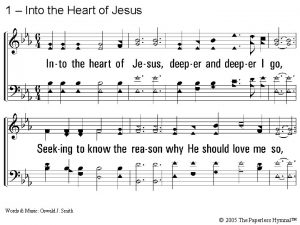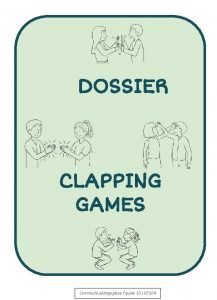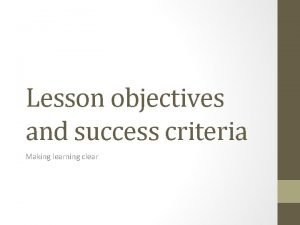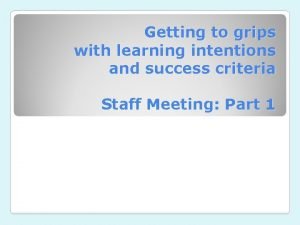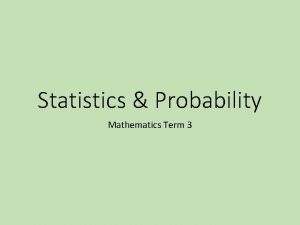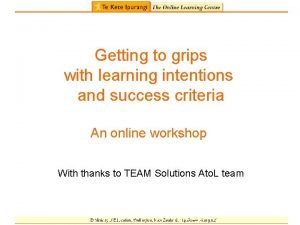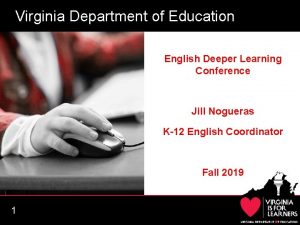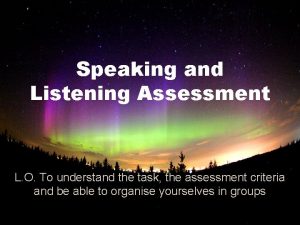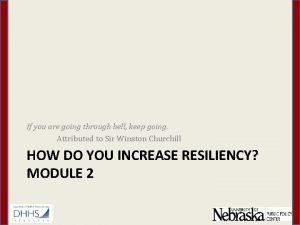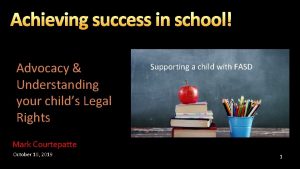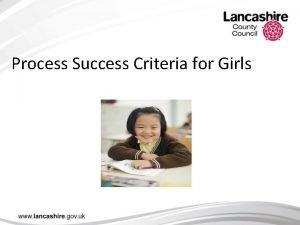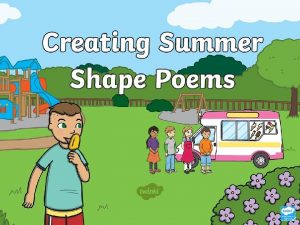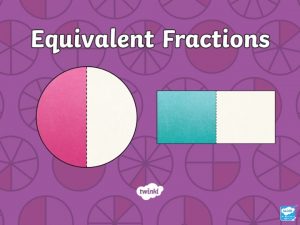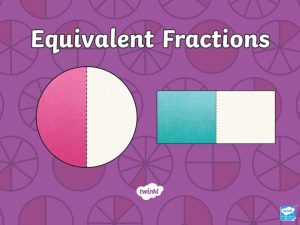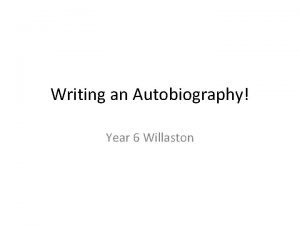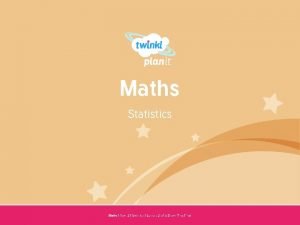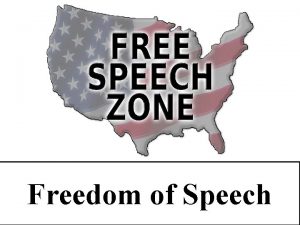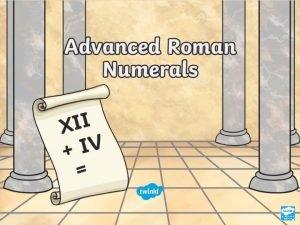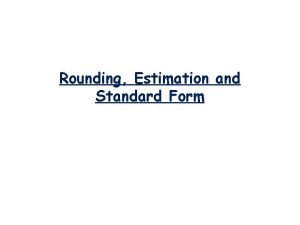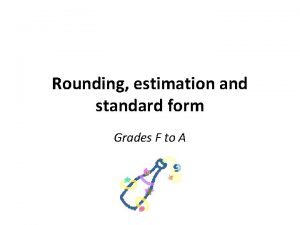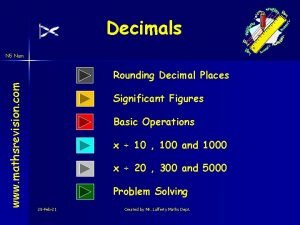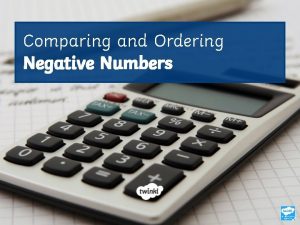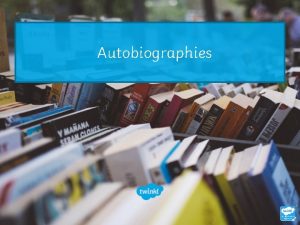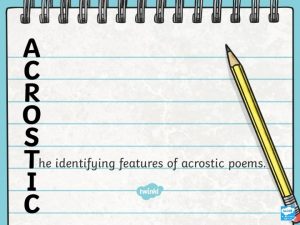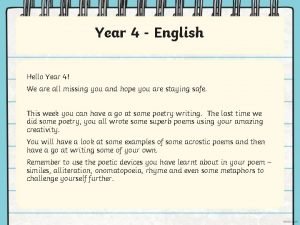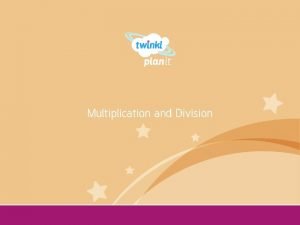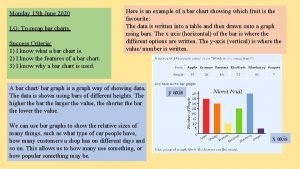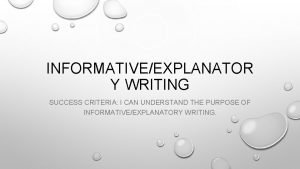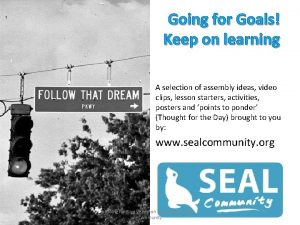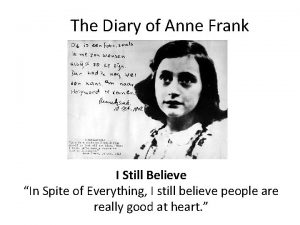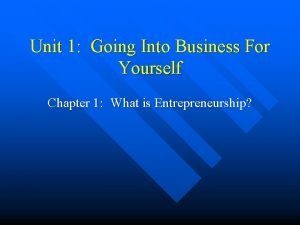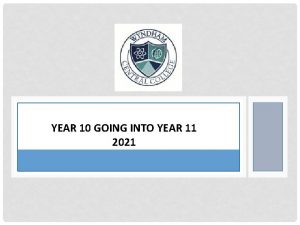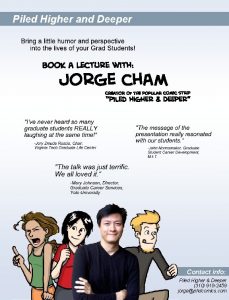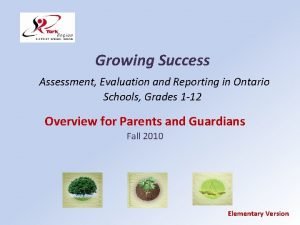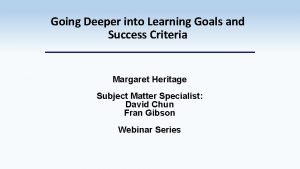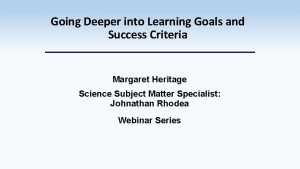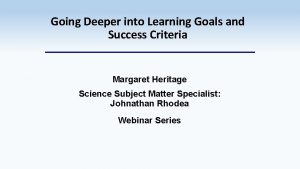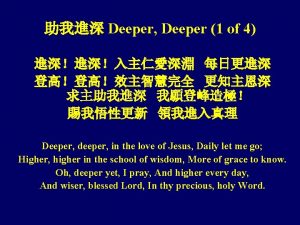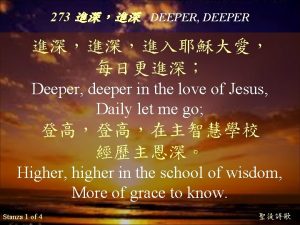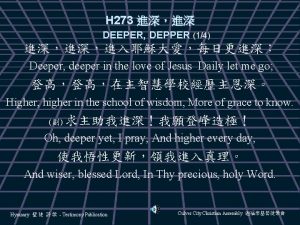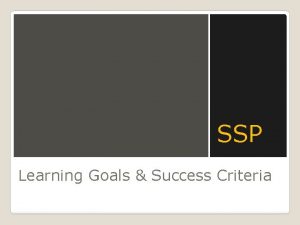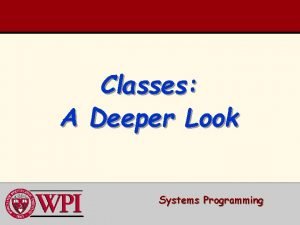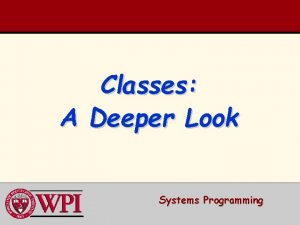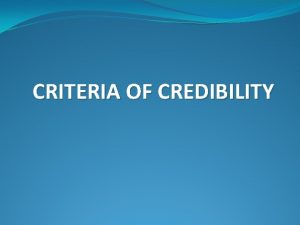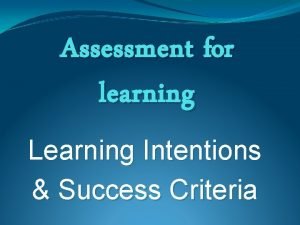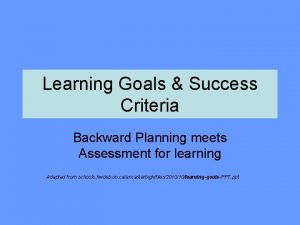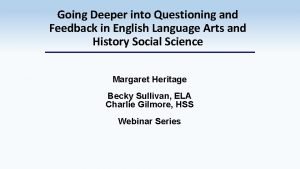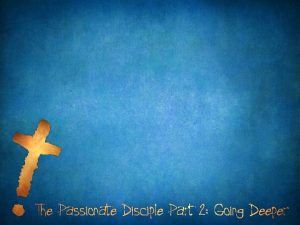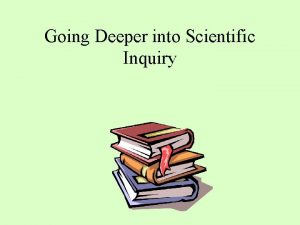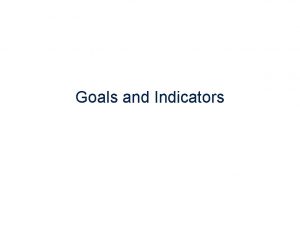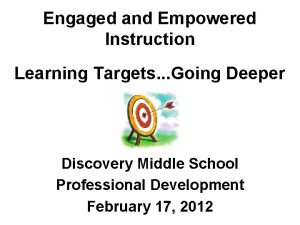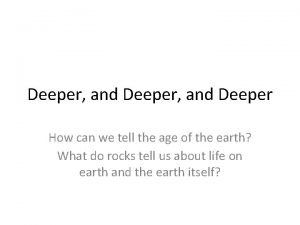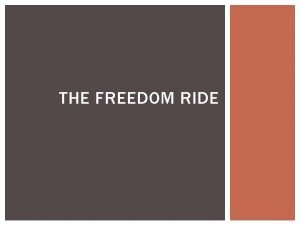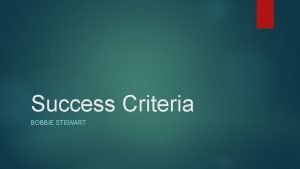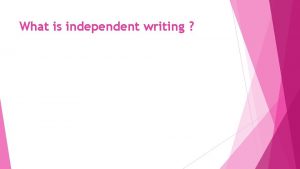Going Deeper into Learning Goals and Success Criteria















































- Slides: 47

Going Deeper into Learning Goals and Success Criteria Margaret Heritage Subject Matter Specialist Charley Gilmore Webinar Series

Learning Goals • • • Understand the role of disciplinary knowledge in establishing learning goals and success criteria Understand how progressions are important for learning goals and success criteria Apply understanding to evaluating learning goals and success criteria

Success Criteria • • • Explain disciplinary considerations for learning goals and success criteria Describe how progressions support learning goals and success criteria Identify stronger and weaker goals and criteria and explain reasons for judgment

ü Formative assessment is the term used to describe a type of assessment where the focus is on informing learning, rather than measuring it or summing it up ü Assessment that focuses on the learning as it is taking place ü Purpose is to move learning forward from its current status

I used to…Now I. . . I used to think that formative assessment was just checking for understanding but now I think it is an integral part of a lesson plan and essential to reaching learning goals.

Guiding Questions • Where am I going? • Where am I now? Close the gap Sadler, 1989 • Where to next?


I know what my students are learning I know how I will know if they’ve learned it

A Sailing Ship on an Unknown Sea to an Unknown Destination A child only knows he is going to school. Very quickly, the daily life onboard ship becomes all important. The daily chores, the demands, the inspections become the reality, not the voyage, nor the destination. Mary Alice White, 1971

I know what I am supposed to be learning I know how I will know when I’ve learned it

Teacher Knowledge Concepts Analytical practices Skills Disciplinary Knowledge

Disciplinary Considerations • SMS - please add to the disciplinary considerations for your content area after the slides that follow • Note- I have not included one for HSS

Disciplinary Considerations: Math • Communicate reasoning about concepts • Justify and explain ideas • Engage students in mathematical practices: o Construct viable arguments and critique the reasoning of others

Disciplinary Considerations: ELA • Reading: Engage with complex texts to build knowledge across the curriculum • Writing: Use evidence to inform, argue and analyze • Speaking and Listening: Work collaboratively, understand multiple perspectives, and present ideas

Disciplinary Considerations: Science • Asking questions (for science) and defining problems (for engineering) • Constructing explanations (for science) and developing designs (for engineering) • Engaging in argument from evidence • Obtaining, evaluating and communicating information

Disciplinary Considerations: HSS • Ask questions and develop a plan to answer those questions • Apply disciplinary tools most appropriate to the questions (civics, economics, geography, history) • Gather and evaluate evidence from a variety of primary and secondary sources • Communicate conclusions demonstrating grade-level literacy and take informed action

Discrete, Atomistic Learning


Connected Learning

Progression Concepts, analytical practices, skills

Where am I going?

Text Complexity RL. 5. 6 Describe how a narrator’s or speaker’s point of view influences how events are described. I have this example for ELA, ELA SS please add two more One from writing, and information text RL. 4. 6 Compare and contrast the point of view from which different stories are narrated, including the difference between first- and third-person narrations. RL. 3. 6 Distinguish their own point of view from that of the narrator or those of the characters. RL. 2. 6 Acknowledge differences in the points of view of characters, including by speaking in a different voice for each character when reading dialogue aloud. RL. 1. 6 Identify who is telling the story at various points in a text. RL. K. 6 With prompting and support, name the author and illustrator of a story and define the role of each in telling the story.

Determining Helpful Sources BY THE END OF GRADE 2 BY THE END OF GRADE 5 BY THE END OF GRADE 8 BY THE END OF GRADE 12 INDIVIDUALLY AND WITH OTHERS, STUDENTS … D 1. 5. K-2. Determine the kinds of sources that will be helpful in answering compelling and supporting questions. D 1. 5. 3 -5. Determine the kinds of sources that will be helpful in answering compelling and supporting questions, taking into consideration the different opinions people have about how to answer the questions. D 1. 5. 6 -8 Determine the kinds of sources that will be helpful in answering compelling and supporting questions, taking into consideration multiple points of views represented in the sources. D 1. 5. 9 -12. Determine the kinds of sources that will be helpful in answering compelling and supporting questions, taking into consideration multiple points of view represented in the sources available, and the potential uses of the sources.

Change, Continuity, and Context BY THE END OF GRADE 2 BY THE END OF GRADE 5 BY THE END OF GRADE 8 BY THE END OF GRADE 12 INDIVIDUALLY AND WITH OTHERS, STUDENTS … D 2. His. 1. K-2. Create a chronological sequence of multiple events. D 2. His. 1. 3 -5. Create and use a chronological sequence of related events to compare developments that happened at the same time. D 2. His. 1. 3 -8. Analyze connections among events and developments in broader historical contexts. D 2. His. 1. 9 -12. Evaluate how historical events and developments were shaped by unique circumstances of time and place as well as broader historical contexts.

Transferable Knowledge and Skills


What Makes a Good Learning Goal? • Clear and linked to the big picture of learning (the purpose and the context for learning) • Focused on the learning • Written/communicated from the students’ perspective (i. e. , not in teacher- or standardsspeak) • Realistic and time-limited (i. e. , span one lesson) • Lead to rich, productive learning experiences

What Makes Good Success Criteria? Clear and closely linked to the learning goal Continue to focus on the learning Illustrate the expected learning Written/communicated from the students’ perspective (i. e. , not in teacher- or standardsspeak) • Support rich, productive learning experiences • •

BIG IDEAS: - DNA is a warehouse of the genetic code that provides information that controls cellular structure and activities. - NGSS framework dimension 2, Crosscutting Concepts, number 6, Structure and Function. - CCSS ELA for science grades 6 -12, reading and writing. PRIOR KNOWLEDGE: Proteins are macromolecules made of specific sequences of amino acids (structure). Proteins have many functions that control cellular structure and activities. LEARNING GOAL: By the end of the lesson students will understand how the structure of DNA relates to its function. TIME: Three blocks of 90 minutes.

Some Success Criteria • Define terms structure and function • Describe the structure of DNA • Explain why the base pair rule means DNA forms complementary strands and a double helix • Demonstrate the process of transcription


Big idea: Organisms have both internal and external macroscopic structures that allow of growth, survival, behavior, and reproduction. Learning goal: Understand the external structure of cacti and its functions. Success Criteria: • Describe external features • Make predictions about the function of the external features • Explain your reasoning

Goals Understand that a unit of measure is proportional to its whole Understand any unit of measure be divided into any number of equal subunits Criteria: Compare parts of a whole to identify the fractional relationship On a number line from 0 -12 accurately plot fractional parts from ½ to 1/12. Explain why on a number line whole numbers increase from left to right but fraction denominators decrease from left to right

Today we are learning how to represent our understanding of a onestep word problem and to use a strategy to solve the problem. The criteria that will guide your learning are: I can identify what the word problem is asking me to do I can use a math strategy to solve the problem(I can use appropriate math tools to help me if I need them) I can give an explanation of my thinking using accurate math vocabulary


Goal: Understand that the main idea is not always stated directly and can be implied in the text Understand how authors imply ideas in the text Success Criteria Explain the main idea of the text Explain how the author implied the main idea in the text


• Understand the difference between fact and opinion Criteria: • Identify facts and opinions in the text • Explain how you know they are either facts or opinions (what were the clues in the text? )

Big Idea: A market economy defines the ways goods and services are produced and distributed and the differences between producers and consumers. (Econ 1) Learning Goal Understand the various ways goods and services are produced and distributed. Success Criteria I can: identify methods of distribution in today’s global economy describe and explain the effect resources have on the production of goods I can: Understand the roles played by producers and • identify examples of producers within our local area consumers in an economy. define consumer and describe the characteristics of consumers provide examples of how producers and consumers are affected by the market economy I can: Understand how the production of goods and explain the methods people and governments use to produce goods and services are determined in a market economy. define the term market economy and give examples

Learning Goal • Use evidence to answer a historical question: What kind of leader was Augustus? Success Criteria • Use source documents to develop hypotheses • Use evidence from source documents to support your hypotheses

Learning Goal • Today we are learning how to make maps of our classroom Success Criteria • Represent a “birds eye” view • Show all the fixed points in the classroom • Show someone could walk around the classroom

• Need to add elementary SS


I used to…Now I. . . • I used to think that formative assessment was purely a form of assessing students at the end of the lesson. Now I see it as an overarching way of designing lessons so that the goals are made very explicit, students are asked to explain where they are with their understanding and that teacher feedback is an essential tool guiding student learning.

Summing Up • Learning goals and success criteria answer the question “where am I going? ” • Disciplinary knowledge is important for LGs and SCs • Knowledge of how learning progresses advantages connected learning

Success Criteria • • • Explain what formative assessment is and where it fits in a comprehensive assessment system Describe the components of a feedback loop formative assessment Explain how learning goals and success criteria drive formative assessment Apply understanding of LGs and SCs to create them Explain how the classroom culture can support or inhibit formative assessment

Thank You! 49
 Into the heart of jesus deeper and deeper i go
Into the heart of jesus deeper and deeper i go Tic tac toe going high going low going criss cross lollipop
Tic tac toe going high going low going criss cross lollipop Strategic goals tactical goals operational goals
Strategic goals tactical goals operational goals Strategic goals tactical goals operational goals
Strategic goals tactical goals operational goals Lesson objectives and success criteria
Lesson objectives and success criteria Example learning intentions
Example learning intentions Learning intentions and success criteria examples
Learning intentions and success criteria examples Learning intentions and success criteria for mathematics
Learning intentions and success criteria for mathematics Example learning intentions
Example learning intentions Vdoe teacher direct
Vdoe teacher direct Speaking and listening success criteria
Speaking and listening success criteria If you are going through hell, keep going means
If you are going through hell, keep going means Your child's success or lack of success
Your child's success or lack of success Your child's success or lack of success
Your child's success or lack of success General goals and specific goals
General goals and specific goals Examples of generic goals and product-specific goals
Examples of generic goals and product-specific goals Success criteria examples
Success criteria examples Shape poem success criteria
Shape poem success criteria G acrostic poem
G acrostic poem Fractions equivalent to 3/8
Fractions equivalent to 3/8 Equivalent fraction of 6/8
Equivalent fraction of 6/8 Characteristics of autobiography
Characteristics of autobiography What is a biography.....
What is a biography..... Success criteria for listening skills
Success criteria for listening skills Tally chart success criteria
Tally chart success criteria Tally chart success criteria
Tally chart success criteria Why does freedom of speech have limits
Why does freedom of speech have limits Cdviii roman numerals
Cdviii roman numerals How to write a number in standard form
How to write a number in standard form Rounding success criteria
Rounding success criteria Informal letter success criteria
Informal letter success criteria Rounding success criteria
Rounding success criteria Success criteria for ordering numbers
Success criteria for ordering numbers Autobiography success criteria
Autobiography success criteria Acrostic poem on success
Acrostic poem on success Acrostic poem
Acrostic poem Multiplication success criteria
Multiplication success criteria Bar chart success criteria
Bar chart success criteria Success criteria for informative writing
Success criteria for informative writing Going for goals
Going for goals Cuadro comparativo de e-learning
Cuadro comparativo de e-learning Where is anne frank buried
Where is anne frank buried Going into business for yourself
Going into business for yourself Going into year 10
Going into year 10 Piled higher and deeper
Piled higher and deeper Planning goals and learning outcomes
Planning goals and learning outcomes Aegean sea troy
Aegean sea troy Growing success assessment
Growing success assessment
